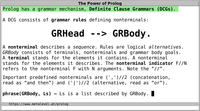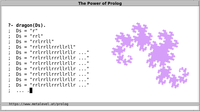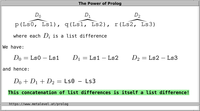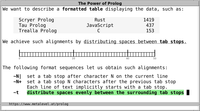Prolog DCG Primer
Introduction
A Prolog definite clause grammar (DCG) describes
a sequence. Operationally, DCGs can be used
to parse, generate, complete and check
sequences manifested as lists.
| Video: |

|
DCGs are of great significance for Prolog: From a
historical perspective, Prolog originated from systems that were
designed for natural language processing, and a built-in mechanism
for efficient parsing that also preserves Prolog's logical
characteristics was one of the most important milestones in its
development. From a practical perspective, DCGs are frequently
used to describe lists because they are so convenient to use.
A DCG is defined by rules. A DCG rule has the form:
Head --> Body.
A rule's body consists of terminal, nonterminals, and
grammar goals. A terminal is a list, and stands for
the elements it contains. These elements are
terminal symbols of the grammar. A nonterminal
refers to a DCG or other grammar construct, and stands for the
elements it describes. A nonterminal therefore stands for a
sequence of terminal symbols. A grammar goal is
written in curly brackets as { Goal } and
is used to invoke Prolog goals within a grammar.
We use the nonterminal indicator A//N to
refer to the nonterminal A with
arity N. Note that // distinguishes it
from a
Prolog predicate indicator.
As an example of a DCG, let us describe sequences whose every element
is the atom a. We shall use the
nonterminal as//0 to refer to such sequences:
as --> [].
as --> [a], as.
The first rule states: The empty sequence is such a sequence. The second
rule uses the nonterminal (',')//2, which we read as
"and then". Therefore, the second rule states: A sequence
that contains as its first element the atom a and
then only atoms a is also such a sequence.
To invoke a grammar rule, we use Prolog's
built-in phrase/2 predicate. The first argument is,
syntactically, a DCG body. phrase(Body,
Ls) is true iff Body describes the
list Ls.
For example, let us use the single nonterminal as//0
to ask for all lists that it describes, by posting
the most general query:
?- phrase(as, Ls).
Ls = []
; Ls = [a]
; Ls = [a,a]
; Ls = [a,a,a]
; Ls = [a,a,a,a]
; ... .
Prolog lets us write lists of characters,
i.e., strings, very conveniently if the
Prolog flag double_quotes is set to chars, for
example by posting the query:
?- set_prolog_flag(double_quotes, chars).
true.
or by adding the following directive in your initialisation file
or program:
:- set_prolog_flag(double_quotes, chars).
We strongly recommend using this setting for better readability
of programs, queries and answers. In Scryer Prolog and
Tau Prolog, this is already the default setting.
With double_quotes set to chars, the list of
characters [a,a,a] can be written equivalently
as "aaa", and a Prolog system may therefore report the
solutions above equivalently and more compactly as:
?- phrase(as, Ls).
Ls = []
; Ls = "a"
; Ls = "aa"
; Ls = "aaa"
; Ls = "aaaa"
; ... .
Throughout this text, we assume that the Prolog
flag double_quotes is set to chars.
Examples of more specific queries and the system's answers:
?- phrase(as, "aaa").
true
; false.
?- phrase(as, "bcd").
false.
?- phrase(as, [a,X,a]).
X = a
; false.
Describing sequences with seq//1, seqq//1 and ... //0
Let us define the nonterminal seq//1 to describe a
sequence of elements. We use its single argument to refer to the
sequence that it describes, represented as a list:
seq([]) --> [].
seq([E|Es]) --> [E], seq(Es).
Sample use case:
?- phrase(("Hello, ",seq(Cs),"!"), "Hello, all!").
Cs = "all"
; false.
Note that in cases where we use DCGs only to generate
lists, you might be tempted to define seq//1 as follows:
badseq(Ls) --> Ls.
This still works as expected in cases like:
?- phrase(badseq("abc"), Ls).
Ls = "abc".
However, it is still not a good idea for two reasons: First, it
cannot be used in the other direction and is thus not a pure
relation:
?- phrase(badseq(Ls), "abc").
error(instantiation_error,phrase/3).
Second, such a simplistic definition can be tricked into invoking
arbitrary code by specifying {Goal} as the argument, as
in:
?- phrase(badseq({halt}), _).
For these two reasons, it is better to use the definition
of seq//1 shown above to refer to arbitrary lists
with DCGs.
Using seq//1, we can define seqq//1 to describe
a sequence of sequences:
seqq([]) --> [].
seqq([Es|Ess]) -->
seq(Es),
seqq(Ess).
Sample use:
?- phrase(seqq(["ab","cd","ef"]), Ls).
Ls = "abcdef".
This is an elegant way to describe the concatenation of
arbitrarily many lists.
It is sometimes useful to describe "any sequence at all", and we can
do this with the nonterminal ... //0 which is
equivalent to seq(_):
The grammar construct ('|')//2 and its
equivalent (;)//2 correspond to the Prolog control
structure (;)/2 and are read as "or". When parsing
with DCGs, using ('|')//2 is preferable over (;)//2
due to existing conventions for writing grammars.
seq//1, seqq//1 and ... //0 are very
versatile nonterminals and can be used to elegantly solve many
tasks that involve reasoning over lists. For example, the last
element of a list can be described with:
?- phrase((...,[Last]), "hello").
Last = o
; false.
As another example, consecutively repeated elements in a list can be described with:
?- phrase((...,[E,E],...), Ls).
Ls = [E,E]
; Ls = [E,E,_A]
; Ls = [E,E,_A,_B]
; Ls = [E,E,_A,_B,_C]
; ... .
Using iterative deepening, we obtain a fair enumeration of answers:
?- length(Ls, _), phrase((...,[E,E],...), Ls).
Ls = [E,E]
; Ls = [E,E,_A]
; Ls = [_A,E,E]
; Ls = [E,E,_A,_B]
; Ls = [_A,E,E,_B]
; Ls = [_A,_B,E,E]
; ... .
In Scryer Prolog, seq//1, seqq//1
and ... //0 are provided
by library(dcgs).
List reversal, palindromes and other exercises
When reasoning about lists or solving exercises involving lists,
consider using DCGs for convenience.
| Video: |

|
For example, the reversal of a list can be described with:
reversal([]) --> [].
reversal([L|Ls]) --> reversal(Ls), [L].
Sample query and answer:
?- phrase(reversal("abcd"), Ls).
Ls = "dcba".
As another example, a palindrome can be described with:
palindrome --> [].
palindrome --> [_].
palindrome --> [E], palindrome, [E].
This definition can be used to generate, to complete
and to check palindromes. For example:
?- phrase(palindrome, "hellolleh").
true
; false.
?- phrase(palindrome, Ls).
Ls = []
; Ls = [_A]
; Ls = [_A,_A]
; Ls = [_A,_B,_A]
; Ls = [_A,_B,_B,_A]
; ... .
Challenge: Define palindrome//0
using reversal//1. Provide two different definitions.
Relating trees to lists
Let us now use a DCG to relate a binary tree to the in-order
sequence of its node names. Let us assume a binary tree consists
of leaves represented by the atom nil and inner
nodes of the form node(Name, Left, Right),
where Left and Right are themselves binary
trees. To obtain the in-order sequence of node names, consider:
tree_nodes(nil) --> [].
tree_nodes(node(Name, Left, Right)) -->
tree_nodes(Left),
[Name],
tree_nodes(Right).
Example:
?- phrase(tree_nodes(node(a, node(b, nil,
node(c, nil, nil)),
node(d, nil, nil))), Ns).
Ns = "bcad".
You can obtain other orders by moving the
terminal [Name] in the DCG body.
Left recursion
Conversely, given a sequence of node names, what are the trees
that yield this sequence:
?- phrase(tree_nodes(Tree), "abcd").
Tree = node(a,nil,node(b,nil,node(c,nil,node(d,nil,nil))))
; % (nontermination)
The system yields one (correct) solution, then loops. This is
because the grammar is left-recursive: We recursively refer to a
nonterminal (tree_nodes//1) before anything else. To be
able to use this grammar for finding all matching trees, we need
to encode that for the second rule to apply, at least one list
element must be available since the rule contains exactly one
terminal, and we need to check this in advance to avoid unbounded
recursion. We can do this by introducing two additional arguments
that let us limit the number of rule applications to the given
list's length:
tree_nodes(nil, Ls, Ls) --> [].
tree_nodes(node(Name, Left, Right), [_|Ls0], Ls) -->
tree_nodes(Left, Ls0, Ls1),
[Name],
tree_nodes(Right, Ls1, Ls).
Each respective pair of additional arguments describes a
so-called list difference. To understand this method
and its associated terminology, consider for example the
pair Ls0 and Ls1. We can interpret
the difference of these lists as describing the list of
elements that are consumed by the first recursive invocation
of tree_nodes//3 in this example. Analogously, the
difference of the lists Ls1 and Ls is the
list of elements consumed by the second invocation. And the
difference between the lists that occur in the head, i.e.,
that of [_|Ls0] and Ls, describes the list of
elements that are consumed by the entire second rule.
| Video: |

|
Of course, difference is to be understood in
a symbolic sense in these cases, not in an arithmetic
sense. For example, the difference between the
lists [A,B,C] and [C]
is [A,B], the difference between [X,Y|Ls]
and Ls is [X,Y], and the difference
between Ls and Ls is []. By
reasoning about such list differences via argument
pairs, we can compose and decompose entire lists by reasoning
about their sublists. This powerful method is in fact also the
key idea that underlies the
common transformation of DCGs to
Prolog predicates. In cases where you are using it, consider
using DCGs instead. In the present case, we are using list
differences explicitly because we are using
them within DCGs.
In the literature, you will also encounter the
term "difference list". However, this terminology is
misleading: We are not talking about—as the name may
suggest—a special kind of list. The additional
arguments are completely
ordinary lists or partial lists.
It is their differences that matter especially in such
cases.
When working with list differences, you may be tempted to
pass around each pair as a single argument, for example as
compound terms like Ls0-Ls1 or Ls0/Ls1. However,
this is not advisable, primarily because you will likely run into
conflicts with other predicates and DCG expansions, and
secondarily because it incurs performance overhead for
constructing, decomposing and managing these compound terms.
Example query:
?- Ns = "abcd", phrase(tree_nodes(Tree, Ns, _), Ns).
Ns = "abcd", Tree = node(a,nil,node(b,nil,node(c,nil,node(d,nil,nil))))
; Ns = "abcd", Tree = node(a,nil,node(b,nil,node(d,node(c,nil,nil),nil)))
; Ns = "abcd", Tree = node(a,nil,node(c,node(b,nil,nil),node(d,nil,nil)))
; ... .
Another option to parse with left-recursive grammars is to use
your Prolog system's tabling
mechanism. Combining tabled execution with DCGs
yields packrat parsing; an interesting paper about
this topic
is DCGs
+ Memoing = Packrat Parsing, But is it worth it? by Ralph
Becket and Zoltan Somogyi.
Semicontext notation
Using semicontext notation, in now outdated terminology
also called pushback lists or right-hand context, we
can make statements about remaining elements. Operationally
speaking, we can insert list elements that were initially not in
the list that is being parsed. A DCG rule of the form:
Head, [T1,...,Tn] --> Body.
can be read operationally as: parse the list
using Body, then prepend the
terms T1, ..., Tn to the remaining list.
For example:
nt1, [b] --> [a].
nt2 --> [b].
The body of nt1//0 describes a list whose single element
is the atom a. Operationally, after nt1//0
has consumed the atom a in a list that is being
parsed, it inserts the atom b in front of the
remaining list. nt2//0 describes a list whose single
element is the atom b. The following query therefore
succeeds, since nt2//0 consumes the atom b,
which is left in the list after nt1//0 succeeds:
?- phrase((nt1,nt2), "a").
true.
We can also use nt1//0 in isolation. However, the following query
fails since phrase/2 only succeeds if all list elements
are consumed by the given DCG body:
?- phrase(nt1, "a").
false.
The list difference version phrase/3 shows what remains
after nt1//0 succeeds:
?- phrase(nt1, "a", Rest).
Rest = "b".
As expected, the atom b remains in the list.
Using semicontext notation, we can implement look ahead,
which lets us inspect the next element in the list without
removing it. Operationally, we first remove it and then push it
back:
look_ahead(T), [T] --> [T].
Example:
?- phrase(look_ahead(T), "a", Rest).
Rest = "a", T = a.
Implicitly passing states around
Semicontext notation is also useful to
implicitly pass around a state representation that is only
accessed and changed by a subset of rules. For example, let us
count the leaves in a binary tree with the above
presentation. Without using DCGs, we can relate a tree to the
number of its leaves as follows:
num_leaves(Tree, N) :-
num_leaves_(Tree, 0, N).
num_leaves_(nil, N0, N) :- N #= N0 + 1.
num_leaves_(node(_,Left,Right), N0, N) :-
num_leaves_(Left, N0, N1),
num_leaves_(Right, N1, N).
Notice that in the second clause of num_leaves_/3, the
accumulator is only passed through
as N0, N1, ..., N and not
modified directly. When you encounter such a pattern, consider
using DCG notation to pass around the arguments implicitly.
In this concrete case, the state we shall pass around is a
single integer denoting the number of leaves encountered so far.
To increment the state, we use
Prolog's declarative integer
arithmetic like above. To invoke a Prolog predicate from
within a DCG body, we use the DCG language
construct {}//1. Operationally, when the
construct {Goal} is encountered in a DCG
body, Goal is called as a Prolog goal. Since
a DCG must always describe a list, we wrap the state into a
list and thus describe a list containing a single element. The
initial state is again sensibly specified as 0, and the
number of leaves is given by the remaining list element
after num_leaves_//1 succeeds:
num_leaves(Tree, N) :-
phrase(num_leaves_(Tree), [0], [N]).
num_leaves_(nil), [N] --> [N0], { N #= N0 + 1 }.
num_leaves_(node(_,Left,Right)) -->
num_leaves_(Left),
num_leaves_(Right).
Notice that the second rule of num_leaves_//1 makes no
reference at all to the state, since the number of leaves is not
modified when an inner node is processed.
Example query:
?- num_leaves(node(a,node(b,nil,nil),
node(c,nil,
node(d,nil,nil))), N).
N = 5.
The following nonterminals are useful for describing states with
DCGs:
state(S), [S] --> [S].
state(S0, S), [S] --> [S0].
Note: Code in grey boxes may be useful for you to reuse in
your own projects.
The nonterminal state(S) can be read as: "The current
state is S". The nonterminal state(S0, S) can be
read as: "The current state is S0, and henceforth it
is S".
Using state//2, you can write num_leaves_//1 as:
num_leaves_(nil) --> state(N0, N), { N #= N0 + 1 }.
num_leaves_(node(_,Left,Right)) -->
num_leaves_(Left),
num_leaves_(Right).
This approach is readily generalized to multiple states that are
threaded through: You can for example use a
term s(S1,S2,...,Sn) in such cases.
Reading from files
In Scryer Prolog, SICStus Prolog and SWI-Prolog, DCGs can be
transparently applied to files using Ulrich
Neumerkel's library(pio).
When you need to process input from files, first write a DCG that
describes the input. This lets you test the DCG in a pure way
using phrase/2, and then apply the DCG to files too
by simply using phrase_from_file/2 instead
of phrase/2.
| Video: |

|
In our first example, we read a whole file to a list of
characters. This is very easy to do with seq//1 as
defined above. For example, to read the contents of the
file dcg.html to a list of characters, we use:
?- phrase_from_file(seq(Chars), "dcg.html").
Chars = "<!DOCTYPE html>\n<ht ..."
; false.
As another example, consider the following DCG that
uses seq//1 to refer to a subsequence of characters:
like(What) --> "I like ", seq(What), ".", ... .
As before, we can use this DCG to parse a given list of characters:
?- phrase(like(What), "I like it. Anything can follow!").
What = "it"
; false.
As expected, What is unified with the atoms i
and t.
Moreover, using library(pio) and
its phrase_from_file/2, we can transparently parse from a
file with the same DCG. Assume that the
file like.txt starts with the string "I like it."
?- phrase_from_file(like(What), "like.txt").
What = "it"
; false.
Again, What is unified with the atoms i
and t.
Pure input via library(pio) can be implemented in such a
way that it uses memory efficiently when parsing files: First, the
file can be read lazily, reading only as much as is needed.
Second, file contents can be very compactly represented in memory
if your Prolog system supports an
efficient representation of lists of
characters. Third, file contents that are no longer relevant for
parsing can be reclaimed automatically if your Prolog system
satisfies the properties outlined
in Precise
Garbage Collection in Prolog.
For these reasons, library(pio) is well-suited
also for parsing large files.
Parsing tricks and techniques
When parsing, we often want to consume tokens greedily,
meaning that the longest match should be given priority. We
can do this by ordering the DCG rules accordingly. For
example, the following DCG describes a list of whitespace
characters in such a way that the longest such sequence is the
first solution, using char_type/2
from library(charsio) for character classification:
ws --> [W], { char_type(W, whitespace) }, ws.
ws --> [].
Identifiers that must start with a letter and may contain
either letters or digits can be parsed by applying this technique:
identifier([A|As]) --> [A], { char_type(A, alpha) }, symbol_r(As).
symbol_r([A|As]) --> [A], { char_type(A, alnum) }, symbol_r(As).
symbol_r([]) --> [].
As another technique that is sometimes useful for parsing, here
are DCG rules that describe a list of lines that are
terminated by line feed or end of file:
lines([]) --> call(eos), !.
lines([L|Ls]) --> line(L), lines(Ls).
line([]) --> ( "\n" | call(eos) ), !.
line([C|Cs]) --> [C], line(Cs).
eos([], []).
The nonterminal call//1 is used to call a Prolog
predicate in such a way that the implicit DCG arguments are made
available as explicit arguments. We need this to describe the
condition "end of string". The grammar construct
!//0 is used like the corresponding Prolog control
structure.
We can use these definitions to obtain the contents of a file as
a list of lines for further reasoning:
?- phrase_from_file(lines(Ls), "like.txt").
Ls = ["I like it. Anythi ..."].
Note: eos/2 is comparatively rarely needed. In the
above case it is used because anything else is the
beginning of a new line. Typically, you can more directly express
what you want to describe, and phrase/2
and phrase_from_file/2 only succeed if
the complete list or file matches the description.
Therefore, it is typically not necessary to explicitly refer to
"end of the string".
Describing output
DCGs are also useful for describing output, because output
is a list of characters.
In library(format),
Scryer Prolog provides the nonterminal format_//2 to
declaratively describe output based on a format string
that defines the layout of specified arguments.
| Video: |

|
For example, we can describe a table with format_//2:
table -->
row([this,is,a]),
row([very,nice,table]).
row(Ls) --> format_("~t~w~7+~t~w~7+~t~w~7+~n", Ls).
Sample query and its results:
?- phrase(table, Ts).
Ts = " this is ...".
An important advantage of this declarative way to describe output
is that we can write test cases and reason about it:
It is quite hard to reason about output that only appears on the
system terminal, with no other tangible manifestation. In
contrast, it is easy to state properties that must hold about a
list of characters.
When needed, we can show the table on the terminal with a single
call of format/2:
?- phrase(table, Ts), format("~s", [Ts]).
this is a
very nice table
Ts = " this is ...".
Implementation
To see how DCGs are internally implemented in Scryer Prolog, we
can use listing/1 from library(format). For
example, to see the actual source code of num_leaves_//1,
we declare the nonterminal dynamic via the dynamic/1
directive, and use:
?- listing(num_leaves_//1).
num_leaves_(nil,A,B) :-
state(C,D,A,E),
D#=C+1,
E=B.
num_leaves_(node(A,B,C),D,E) :-
num_leaves_(B,D,F),
num_leaves_(C,F,E).
We see that internally, the two DCG rules
of num_leaves_//1 were translated into Prolog rules with
two additional arguments, following mechanical rewriting steps.
The translation of DCGs to Prolog code is done
by term_expansion/2, a mechanism analogous
to macros in other languages.
For portability, it is best not to rely on a particular expansion
method. Instead, use semicontext notation to refer to states and
always use the phrase/[2,3] interface to invoke a DCG.
This way, a Prolog system is free to apply a different expansion
method that may be more efficient. For example, the last two
arguments may as well be swapped and allow more efficient
predicate calls this way due to specifics of a particular virtual
machine.
Using DCGs
Consider using DCGs if you are:
- describing a list
- reading from a file
- passing around a state representation that only a few
predicates actually use or modify.
In every serious Prolog program, you will find many opportunities to
use DCGs due to some subset of the above reasons.
Let us study one side-by-side comparison of a regular Prolog
predicate and an equivalent DCG nonterminal to recall several
important aspects of using DCGs and make some additional
observations. We take the well-known Prolog
predicate include/3 as an example:
| regular Prolog |
Prolog DCG |
include(Goal, List, Included) :-
include_(List, Goal, Included).
include_([], _, []).
include_([L|Ls], Goal, Included0) :-
( call(Goal, L) ->
Included0 = [L|Included]
; Included0 = Included
),
include_(Ls, Goal, Included).
|
include(Goal, List, Included) :-
phrase(include_(List, Goal), Included).
include_([], _) --> [].
include_([L|Ls], Goal) -->
( { call(Goal, L) } ->
[L]
; []
),
include_(Ls, Goal).
|
Usage example for both versions:
?- include(integer, [a,b,c,1,2,e], Is).
Is = [1, 2].
We recall and note in particular:
- phrase/2 must of course be used to refer to a DCG
nonterminal within a regular Prolog predicate
- conversely, {}//1 is used to call a regular Prolog goal within a DCG
- the DCG version needs fewer explicit arguments, making it slightly easier to read and understand
- although it is strongly related to the previous point, it is
still worth mentioning explicitly that the DCG version also
refers to fewer variables
- using a DCG makes immediately clear that a list is
being described.
Take your time and see for yourself which of the two versions you
find easier to read and understand.
Some applications of DCGs that you can download from this site and study:
- markov.pl uses DCGs to
describe output of a Markov chain
- Lisprolog uses DCGs to parse Lisp expressions and to implicitly thread through the state of the environment
- Tist uses DCGs for all of the above
reasons throughout the document
- The comp.lang.prolog FAQ are described with a DCG.
Current developments
As of June 2025, DCGs are part of the Prolog ISO standard
as ISO/IEC TS 13211-3:2025.
See
ISO
Prolog works by Ulrich Neumerkel for more information.
DCG notation is similar to monads which have been adopted as
one of the most versatile among several competing formalisms in
functional programming languages like Haskell. Other
programming languages may also benefit from such constructs.
More about Prolog
Main page





